Quantitative Automatic Non-Invasive Assessment of Material Degradation in Historic Tapestries
Abstract
1. Introduction
2. System Design: HeriTex
2.1. Calibration
2.2. Experimental Measurements in a Historic Tapestry Fragment
3. Results
3.1. Analysis of Results
Comparison with the Traditional Manual Method
4. Discussion
5. Conclusions
Supplementary Materials
Author Contributions
Funding
Data Availability Statement
Conflicts of Interest
Abbreviations
| IR | Infrared |
| NLLS | Non-Linear Least Squares |
| nm | Nanometers |
| cm | Centimeters |
| g | Grams |
| PMMA | Polymethyl Methacrylate |
| LED | Light Emitting Diode |
| LDR | Low Dynamic Range |
| HDR | High Dynamic Range |
| CMOS | Complementary Metal Oxide Semiconductor |
References
- Díaz Cabeza, M.d.C. Criterios y Conceptos Sobre el Patrimonio Cultural en el Siglo XXI; Materiales de Enseñanza, año 1, Nº1; Universidad Blas Pascal: Córdoba, Argentina, 2010. [Google Scholar]
- Rogerio Candelera, M.A.; Saaiz Jiménez, C. (Eds.) Ciencia y Tecnología Para la Conservación del Patrimonio Cultural; Instituto de Recursos Naturales y Agrobiología de Sevilla (CSIC): Sevilla, Spain, 2011. [Google Scholar]
- Campbell, T.P. Tapestry in the Baroque: “Threads of Splendor”; O’ Neill, J.P., Rennolds, C.M., Aspinwall, M., Eds.; The Metropolitan Museum of Art: New York, NY, USA, 2007. [Google Scholar]
- Kissi, N.; Curran, K.; Vlachou-Mogire, C.; Fearn, T.; McCullough, L. Developing a non-invasive tool to assess the impact of oxidation on the structural integrity of historic wool in Tudor tapestries. Herit. Sci. 2017, 5, 1–13. [Google Scholar] [CrossRef]
- Holwell Duffus, P. Manufacture, Analysis and Conservation Strategies for Historic Tapestries; University of Manchester: Manchester, UK, 2013. [Google Scholar]
- Lennard, F.; Hayward, M. Tapestry Conservation. Principle and Practice; Oddy, A., Ed.; Butterworth-Heinemann: New York, NY, USA, 2011; 33p. [Google Scholar]
- Tripa, S.; Indrie, L.; Tripa, F.; Mare, M. A review on deterioration of textile cultural heritage objects and sustainable solutions to mitigate the degradation. Ind. Textila 2023, 74, 555–563. [Google Scholar] [CrossRef]
- Kosel, J.; Legan, L.; Bračič, M.; Ropret, P. Cationic silicone based paper impregnation agent for the protection of historical paper against fungal growth. Detection and quantification of fungi using micro-invasive fluorescence microscopy and non-invasive FTIR spectroscopy. J. Cult. Herit. 2024, 68, 195–204. [Google Scholar] [CrossRef]
- Ljaljević Grbić, M.; Dimkić, I.; Janakiev, T.; Kosel, J.; Tavzes, Č.; Popović, S.; Knežević, A.; Legan, L.; Retko, K.; Ropret, P.; et al. Uncovering the Role of Autochthonous Deteriogenic Biofilm Community: Rožanec Mithraeum Monument (Slovenia). Microb. Ecol. 2024, 87, 87. Available online: https://pubmed.ncbi.nlm.nih.gov/38940862/ (accessed on 21 April 2025). [CrossRef]
- Vargas, W.E. Light scattering and absorption by non homogeneous materials: The Kubelka-Munk model. Opt. Pura Apl. 2011, 44, 163–183. Available online: https://www.sedoptica.es (accessed on 19 July 2024).
- Zhang, H.; Hu, T.; Zhang, J. Transmittance of Infrared Radiation Through Fabric in the Range 8–14 μm. Text. Res. J. 2010, 80, 1516–1521. [Google Scholar] [CrossRef]
- Wilhelm, R.H.; Boyd Smith, J. Transmittance, Reflectance, and Absorptance of Near Infrared Radiation in Textile Materials. Text. Res. J. 2015, 19, 73–88. [Google Scholar] [CrossRef]
- Fernandez-Balbuena, A.A.; Gómez-Manzanares, A.; Martínez Antón, J.C.; Gómez-Tejedor, J.G.; Mayorga-Pinilla, S.; Durán Roque, H.; Vázquez Moliní, D. High-Dynamic-Range Spectral Reflectance for the Segmentation of Paint Pigment: Application to Dalí’s Oil Painting Dos Figuras (1926). Sensors 2023, 23, 4316. [Google Scholar] [CrossRef] [PubMed]
- Cabrera Sixto, J.M.; Vidaurri Aréchiga, M.; Pérez Luque, R.A.; Sosa Aquino, M.A.; Guerrero Agripino, L.F.; Aguilera Morales, J.M.; Rodríguez Argote, M.C.; Romero González, E.M.; Villagómez Oviedo, C.P.; Saldaña Hernández, J.C.; et al. Imagen Tecnológica, Proceso y Representación en el Arte y el Diseño, 1st ed.; Cuerpo Académico Representación y Procesos en el Arte y el Diseño R, Ed.; Universidad de Guanajuato: Guanajuato, Mexico, 2014. [Google Scholar]
- Chapra Steven, C.; Canale, R.P. Métodos Numéricos Para Ingenieros, 5th ed.; McGraw-Hill/Interamericana Editores SA: Mexico City, Mexico, 2007; Volume 5, pp. 495–497. [Google Scholar]
- Ababneh, A. Digital Solutions for Cultural Heritage: Preservation, Interpretation, and Engagement in Line with the Venice Charter Principles. CEUR Workshop Proceedings. 2024. Volume 3838. Available online: https://ceur-ws.org/Vol-3838/paper1.pdf (accessed on 21 April 2025).
- Costantini, R.; Lennard, F.; Alsayednoor, J.; Harrison, P. Investigating mechanical damage mechanisms of tapestries displayed at different angles using 2D DIC. Eur. Phys. J. Plus 2020, 135, 515. [Google Scholar] [CrossRef]
- Fernandez-Balbuena, A.; Vazquez-Molini, D. Optical Technologies Applied to Cultural Heritage. Heritage 2022, 5, 359–361. [Google Scholar] [CrossRef]
- Perez, M.; Cano, N.; Ruvalcaba-Sil, J.; Mitrani, A.; de Lucio, O. Technical Non-Invasive Study of an 18th Century Novo-Hispanic Panel Painting. Heritage 2021, 4, 3676–3696. [Google Scholar] [CrossRef]
- Dal Fovo, A.; Striova, J.; Pampaloni, E.; Fedele, A.; Morita, M.M.; Amaya, D.; Grazzi, F.; Cimò, M.; Cirrincione, C.; Fontana, R. Rubens’ painting as inspiration of a later tapestry: Non-invasive analyses provide insight into artworks’ history. Microchem. J. 2020, 153, 104472. [Google Scholar] [CrossRef]
- UNESCO. General Conference 20th, 1978. Actas de la Conferencia General, 20a reunión, París, 24 de Octubre-28 de Noviembre de 1978, v. 1: Resoluciones. Actas de la Conferencia General de la Organización de las Naciones Unidas Para la Educación, la Ciencia y la Cultura (20.a Reunión). 1979, pp. 62–68. Available online: https://unesdoc.unesco.org/ark:/48223/pf0000114032_spa.page=183 (accessed on 22 April 2025).

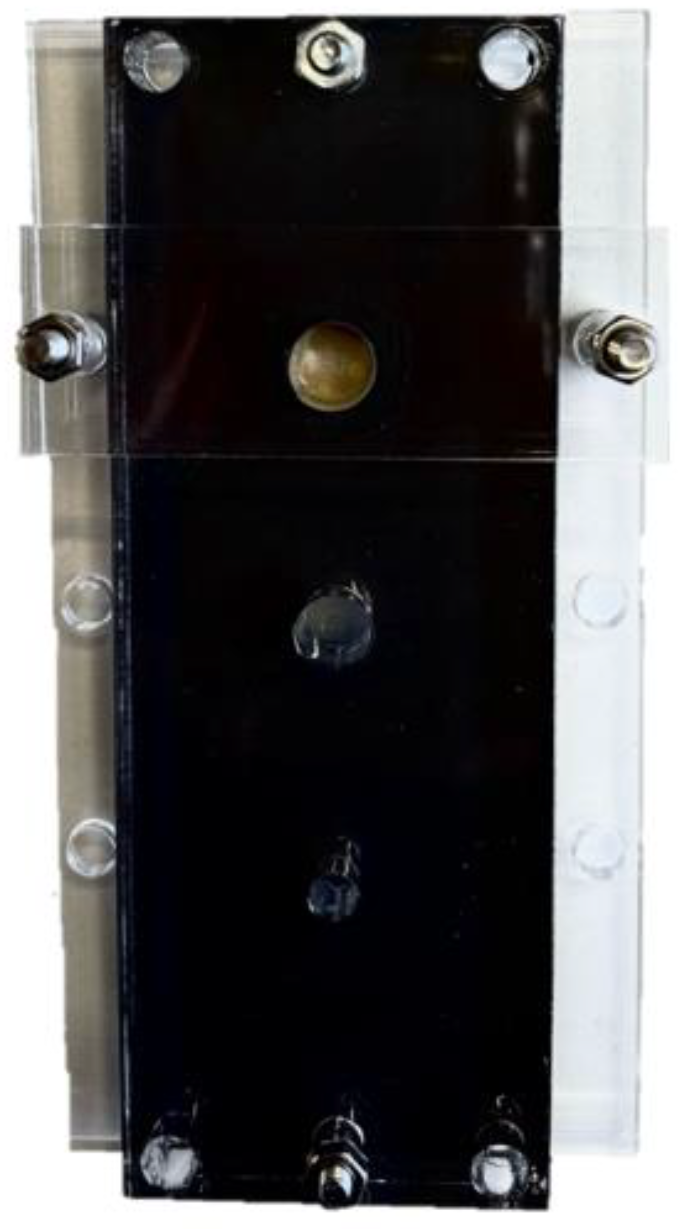
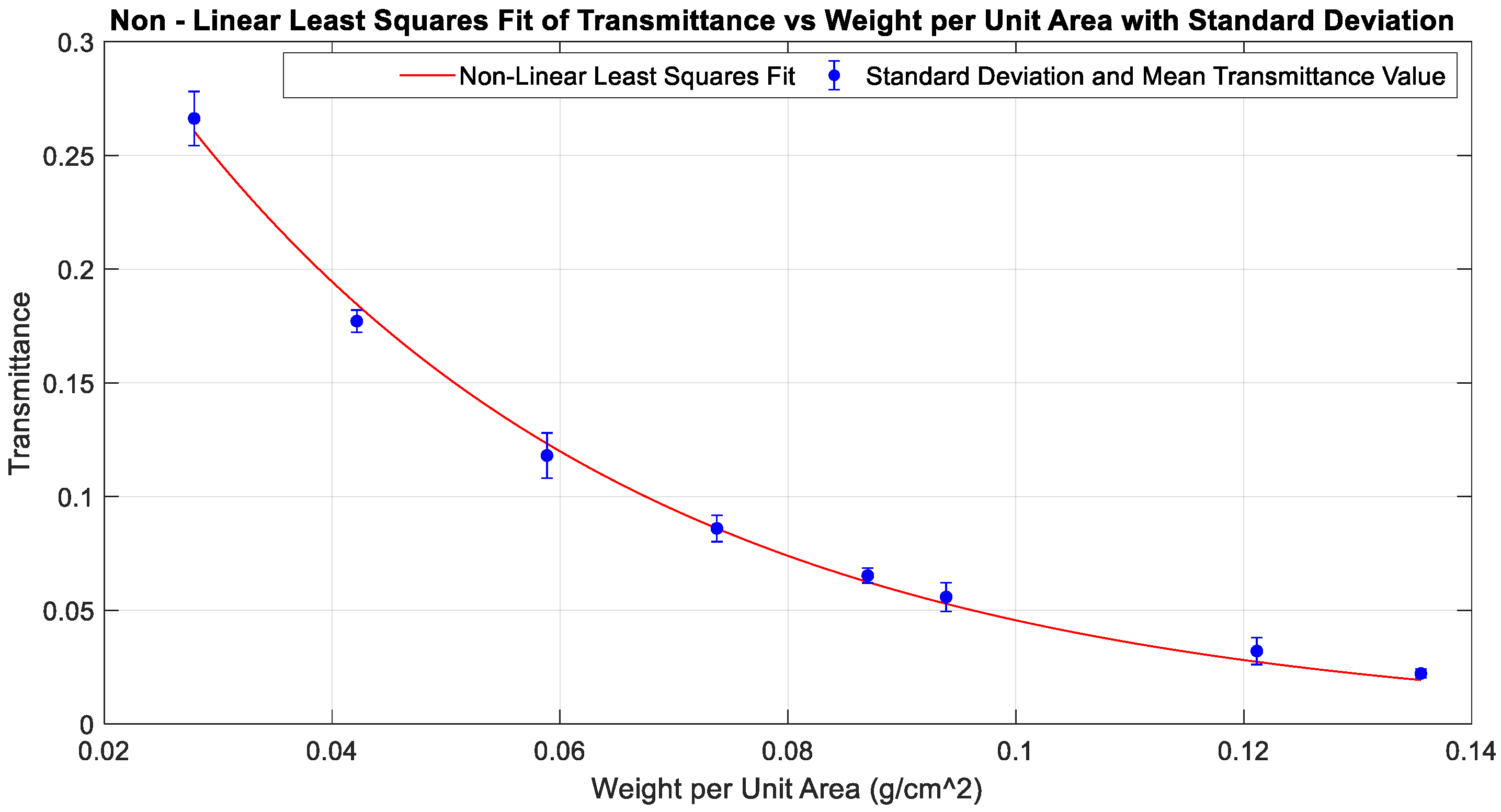
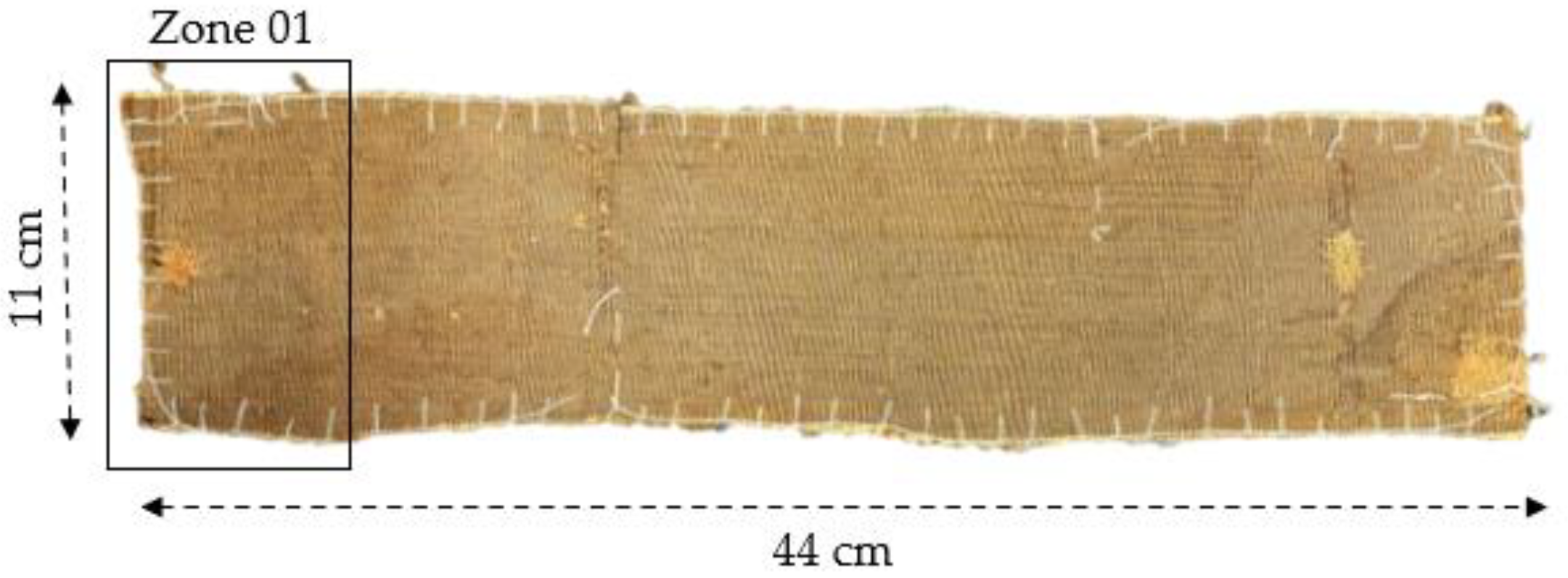
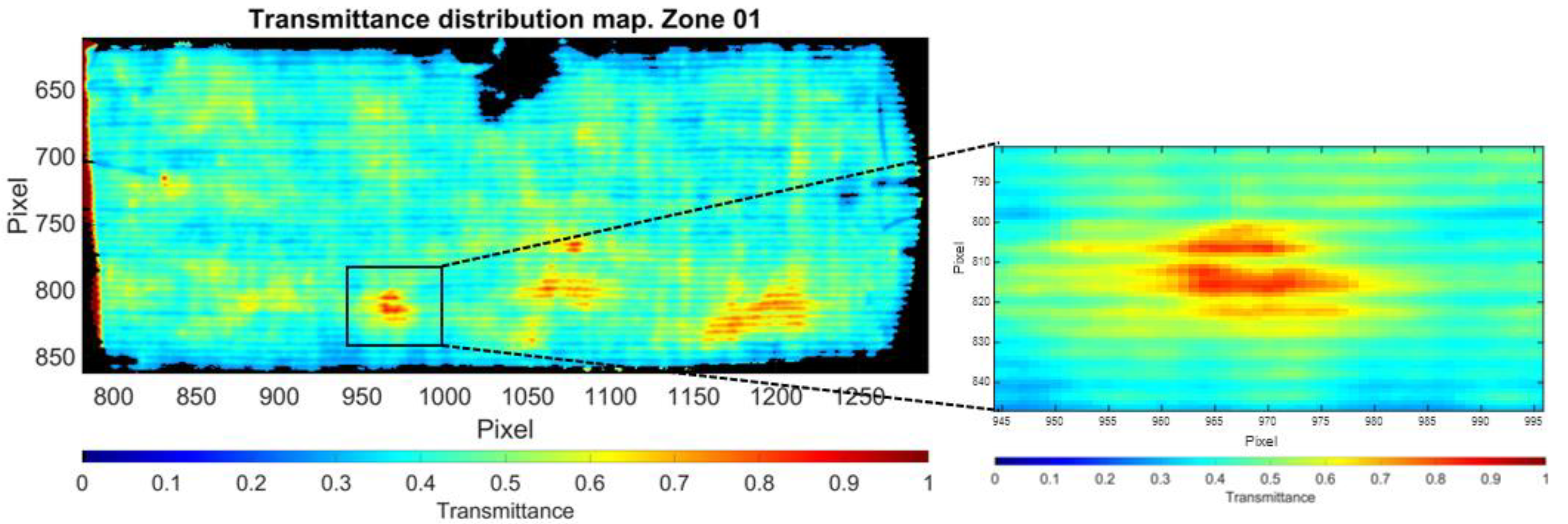
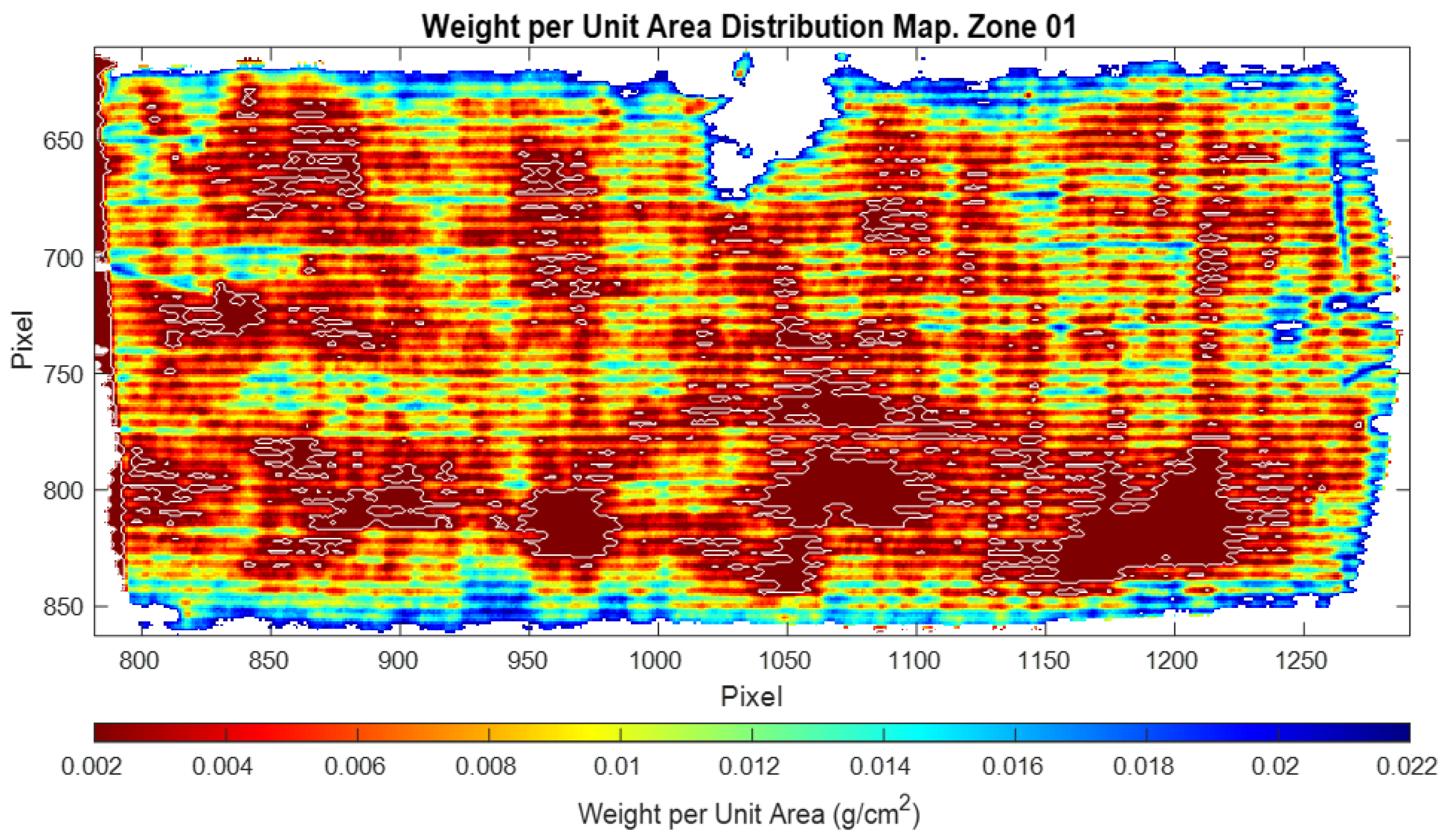
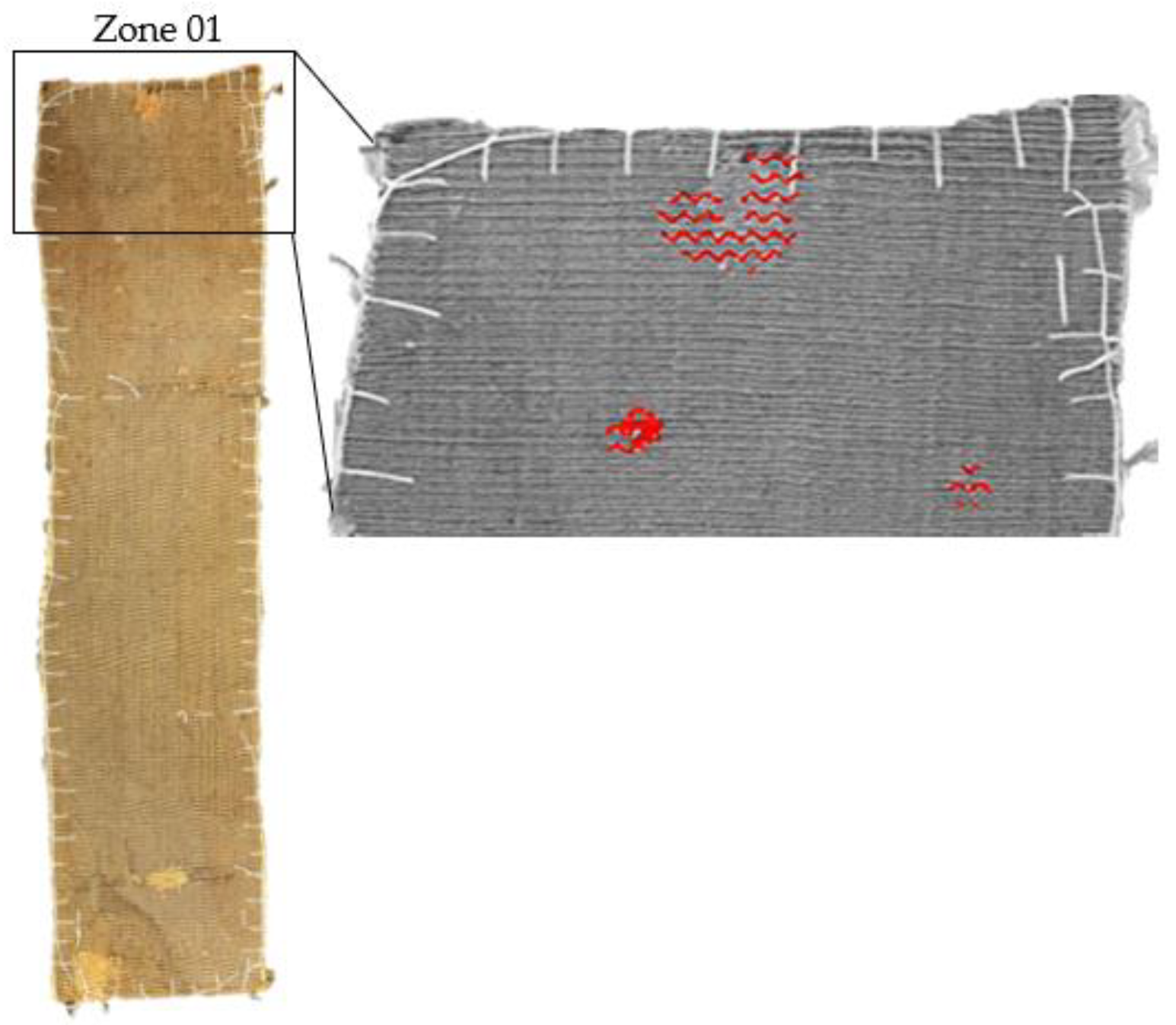

Disclaimer/Publisher’s Note: The statements, opinions and data contained in all publications are solely those of the individual author(s) and contributor(s) and not of MDPI and/or the editor(s). MDPI and/or the editor(s) disclaim responsibility for any injury to people or property resulting from any ideas, methods, instructions or products referred to in the content. |
© 2025 by the authors. Licensee MDPI, Basel, Switzerland. This article is an open access article distributed under the terms and conditions of the Creative Commons Attribution (CC BY) license (https://creativecommons.org/licenses/by/4.0/).
Share and Cite
Sánchez-Cancela, B.; Álvarez Fernández-Balbuena, A.; Vázquez Molini, D.; García Blanco, V.; López Sánchez, A. Quantitative Automatic Non-Invasive Assessment of Material Degradation in Historic Tapestries. Heritage 2025, 8, 153. https://doi.org/10.3390/heritage8050153
Sánchez-Cancela B, Álvarez Fernández-Balbuena A, Vázquez Molini D, García Blanco V, López Sánchez A. Quantitative Automatic Non-Invasive Assessment of Material Degradation in Historic Tapestries. Heritage. 2025; 8(5):153. https://doi.org/10.3390/heritage8050153
Chicago/Turabian StyleSánchez-Cancela, Bárbara, Antonio Álvarez Fernández-Balbuena, Daniel Vázquez Molini, Verónica García Blanco, and Almudena López Sánchez. 2025. "Quantitative Automatic Non-Invasive Assessment of Material Degradation in Historic Tapestries" Heritage 8, no. 5: 153. https://doi.org/10.3390/heritage8050153
APA StyleSánchez-Cancela, B., Álvarez Fernández-Balbuena, A., Vázquez Molini, D., García Blanco, V., & López Sánchez, A. (2025). Quantitative Automatic Non-Invasive Assessment of Material Degradation in Historic Tapestries. Heritage, 8(5), 153. https://doi.org/10.3390/heritage8050153







